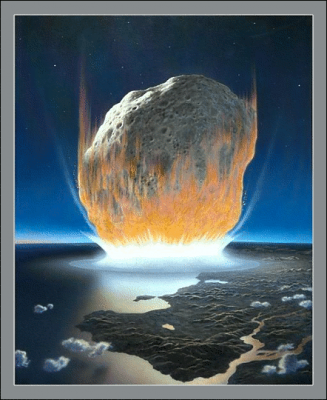If you’re looking for an interesting way to try and grasp the vastness of geological time and the immensity of cosmic forces that have shaped our little planet, here’s something that may be of interest.
Purdue University in Indiana USA, hosts this website http://impact.ese.ic.ac.uk/ImpactEffects/ called Earth Impact Effects. Colloquially it is known as the Catastrophe Calculator. This is great fun for the cosmically curious.
By putting in a variety of parameters like the size of the asteroid, the velocity and composition, the website will generate a complete description of the expected destruction from the impact. You also insert the distance you are observing the hypothetical event from, and the report will tell you what to expect.
As soon as we discovered this in the Land for Wildlife office, the race was on to recreate as closely as possible a modern day incidence of the impact that created Tnorala (Gosse Bluff) 159kms west of Alice Springs.
Using Google Earth and information on the nature of the projectile from the NT Government website, this is what the website gave us;
-
Your Inputs:
- Distance from Impact: 159.00 km ( = 98.70 miles )
- Projectile diameter: 600.00 meters ( = 1970.00 feet )
- Projectile Density: 1000 kg/m3
- Impact Velocity: 30.00 km per second ( = 18.60 miles per second )
- Impact Angle: 45 degrees
- Target Density: 2500 kg/m3
- Target Type: Sedimentary Rock
-
Energy:
- Energy before atmospheric entry: 5.09 x 1019 Joules = 1.22 x 104 MegaTons TNT
- The average interval between impacts of this size somewhere on Earth during the last 4 billion years is 1.5 x 105years
-
Major Global Changes:
- The Earth is not strongly disturbed by the impact and loses negligible mass.
- The impact does not make a noticeable change in the tilt of Earth’s axis (< 5 hundreths of a degree).
- The impact does not shift the Earth’s orbit noticeably.
-
Atmospheric Entry:
- The projectile begins to breakup at an altitude of 89700 meters = 294000 ft
- The projectile reaches the ground in a broken condition. The mass of projectile strikes the surface at velocity 28 km/s = 17.4 miles/s
- The impact energy is 4.44 x 1019 Joules = 1.06 x 104MegaTons.
- The broken projectile fragments strike the ground in an ellipse of dimension 1.66 km by 1.17 km
-
Crater Dimensions:
- What does this mean?
- Crater shape is normal in spite of atmospheric crushing; fragments are not significantly dispersed.
- Transient Crater Diameter: 6.14 km ( = 3.81 miles )
- Transient Crater Depth: 2.17 km ( = 1.35 miles )
- Final Crater Diameter: 7.81 km ( = 4.85 miles )
- Final Crater Depth: 549 meters ( = 1800 feet )
- The crater formed is a complex crater.
- The volume of the target melted or vaporized is 0.279 km3 = 0.0671 miles3
- Roughly half the melt remains in the crater, where its average thickness is 9.45 meters ( = 31 feet ).
-
Thermal Radiation:
- What does this mean?
- Time for maximum radiation: 253 milliseconds after impact
- Visible fireball radius: 5.1 km ( = 3.17 miles )
- The fireball appears 7.29 times larger than the sun
- Thermal Exposure: 5.44 x 105 Joules/m2
- Duration of Irradiation: 1.53 minutes
- Radiant flux (relative to the sun): 5.91
-
Seismic Effects:
- What does this mean? The major seismic shaking will arrive approximately 31.8 seconds after impact.
- Richter Scale Magnitude: 7.3
- Mercalli Scale Intensity at a distance of 159 km:
- VI. Felt by all, many frightened. Some heavy furniture moved; a few instances of fallen plaster. Damage slight. VII. Damage negligible in buildings of good design and construction; slight to moderate in well-built ordinary structures; considerable damage in poorly built or badly designed structures; some chimneys broken.
-
Ejecta:
- What does this mean? The ejecta will arrive approximately 3.05 minutes after the impact.
- At your position there is a fine dusting of ejecta with occasional larger fragments
- Average Ejecta Thickness: 3.15 mm ( = 1.24 tenths of an inch )
- Mean Fragment Diameter: 1.43 cm ( = 0.564 inches )
-
Air Blast:
- What does this mean? The air blast will arrive approximately 8.03 minutes after impact.
- Peak Overpressure: 14400 Pa = 0.144 bars = 2.04 psi
- Max wind velocity: 32 m/s = 71.6 mph
- Sound Intensity: 83 dB (Loud as heavy traffic)
- Damage Description: Glass windows will shatter.
So there you go. A lot of technical stuff there if you’re good at maths, but it seems that in the unlikely event that the Tnorala impact happens again in exactly the same place, all we need worry about is some shattered windows and a light dusting of comet fragments!
Now if you liked that, you can go and try the visual version for a more updated version with some fancy graphics.
http://www.purdue.edu/impactearth
Have fun!
Category:
Uncategorized
